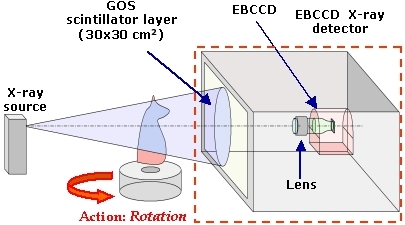|
 Linear
Scanner for NDT Linear
Scanner for NDT
 Digital
Radiography Digital
Radiography
 Computed
Tomography Computed
Tomography
 Intensified Cone Beam CT Intensified Cone Beam CT
 Micro CT Micro CT
 Multislice Tomography Multislice Tomography
 Works carried out at the Getty Works carried out at the Getty
Conservation Institute, Los Angeles
 High Energy Tomography High Energy Tomography
 Old Roman Jug Old Roman Jug
 Etruscan Fibula Etruscan Fibula
 Bronze Head Bronze Head
 Large Objects Large Objects
 Neutron
Tomography Neutron
Tomography
 Iort
Project Iort
Project
 Autoradiography Autoradiography
|
High Energy Tomography



THE EXPERIMENTAL SETUP
The signal is digitized through a 12-bit ADC mounted onboard on the EBCCD camera. The camera provides one digital output provided to the PC. The digital electronics of the EBCCD camera has been developed at Geosphaera Research Center in Moscow and is based on a microprocessor produced by Altera Corporation. The main feature of the presented system is its high spatial resolution, thanks to the pixel size of about 22.5 micrometers, even for large objects (up to 13 cm).
|


